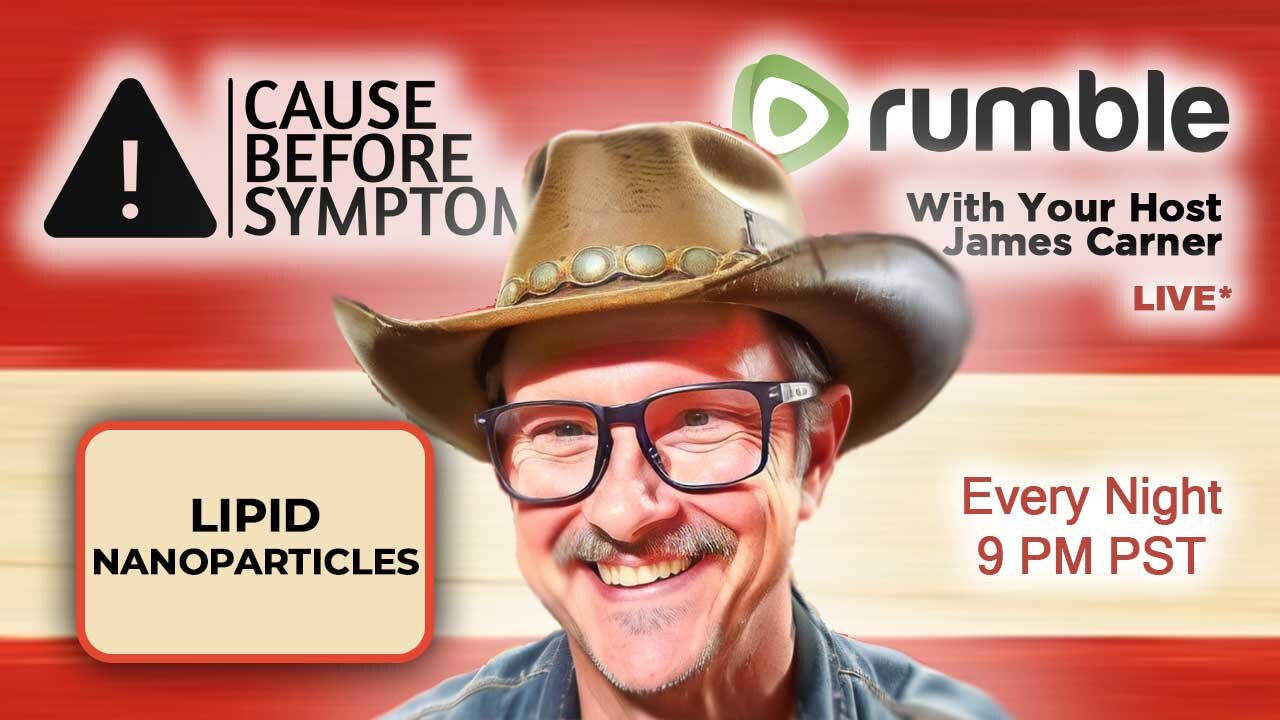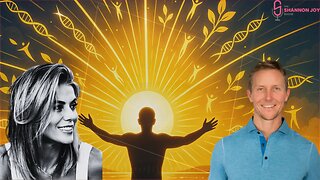Premium Only Content

Lipid Nanoparticles
Cause Before Symptom - With Your Host James Carner
Lipid Nanoparticles
Hydrogels are water-based, soft materials that have become a cornerstone in biomedical research and applications. Their unique properties—such as high water content, flexibility, and biocompatibility—make them ideal for a wide range of uses, including drug delivery, tissue engineering, and regenerative medicine. Hydrogels are three-dimensional networks of polymers that can absorb and retain large amounts of water. These polymers are crosslinked, meaning they form a stable structure that doesn’t dissolve in water. This structure allows hydrogels to mimic the natural environment of human tissues, making them highly compatible with biological systems.
One of the key properties of hydrogels is their high water content, which can reach up to 90%. This creates a moist environment that supports cell growth and tissue repair. Additionally, hydrogels are biocompatible, meaning they are non-toxic and interact well with living tissues, reducing the risk of adverse reactions. Scientists can also tune the mechanical strength, porosity, and degradation rate of hydrogels to suit specific applications. Some hydrogels are even "smart" materials, capable of responding to external stimuli like temperature, pH, or light, which makes them particularly useful for targeted therapies.
Hydrogels have a wide range of applications in the biomedical field. In drug delivery, they are used to control the release of drugs over time. Their porous structure allows drugs to diffuse slowly, ensuring sustained and targeted delivery, which is especially beneficial for treating chronic conditions like diabetes or cancer. In tissue engineering, hydrogels serve as scaffolds for growing new tissues. They provide a supportive environment for cells to attach, multiply, and form functional tissues, such as cartilage, bone, and even heart tissue. Hydrogels are also excellent for wound healing, as they keep the wound moist, promote healing, and can deliver antimicrobial agents directly to the site. Their flexibility and comfort make them ideal for dressing burns or surgical wounds. In regenerative medicine, hydrogels are used to repair damaged tissues and organs by releasing growth factors or stem cells that stimulate the body’s natural healing processes.
Recent advancements in hydrogel technology have further expanded their potential. Self-healing hydrogels, for example, can repair themselves after damage, extending their lifespan and reliability. Injectable hydrogels can be injected into the body in liquid form and then solidify at the target site, making them minimally invasive. Nanocomposite hydrogels, which incorporate nanoparticles, offer enhanced mechanical properties and additional functionalities, such as conductivity or antimicrobial activity. These innovations are pushing the boundaries of what hydrogels can achieve in medicine and beyond.
Despite their immense promise, there are still challenges to overcome with hydrogels. Controlling their degradation rate to match specific applications is one such challenge. Scaling up production without compromising quality is another. Additionally, improving how hydrogels interact with the body to avoid immune responses or rejection is critical for their long-term success. Future research aims to address these challenges and develop even more advanced hydrogels. For example, combining hydrogels with other technologies, like 3D printing, could revolutionize personalized medicine and on-demand tissue fabrication.
Hydrogels are a versatile and powerful tool in modern medicine. From delivering life-saving drugs to regenerating damaged tissues, their potential is vast. As research continues to push the boundaries of what hydrogels can do, they are poised to play an even greater role in improving healthcare outcomes worldwide. Their ability to mimic natural tissues, respond to stimuli, and be tailored for specific needs makes them an invaluable resource in the ongoing quest to advance medical science and patient care.
Hydrogel technology and related biomedical advancements, including drug delivery systems and tissue engineering, are being studied and applied in various regions, including Africa. The extent and focus of these studies often depend on local healthcare needs, funding, and research infrastructure. Africa faces a high burden of infectious diseases such as malaria, HIV/AIDS, and tuberculosis, making hydrogel-based drug delivery systems particularly relevant. For example, hydrogels are being investigated as potential carriers for controlled drug delivery to improve treatment outcomes for malaria by delivering antimalarial drugs in a sustained manner, which could reduce the frequency of doses and improve patient compliance. Similarly, research is exploring hydrogels for delivering antiretroviral drugs for HIV/AIDS, potentially through injectable or implantable systems, which could revolutionize treatment in regions with limited healthcare access.
In addition to infectious diseases, hydrogels are being studied for their ability to promote wound healing and treat burns, which are common in many African countries. Access to advanced wound care is often limited, and hydrogels offer a promising solution due to their ability to maintain a moist environment, deliver antimicrobial agents, and reduce infection. This makes them particularly valuable in low-resource settings where traditional wound care options may be scarce. Furthermore, hydrogels are being explored for regenerative medicine and tissue engineering, which could have significant applications in Africa. For instance, hydrogels could be used to regenerate skin tissue for burn victims, who often face limited treatment options, or to repair bone and cartilage for patients with injuries or degenerative conditions.
Hydrogels are also being researched as delivery systems for vaccines, which could have significant implications for public health initiatives in Africa. For example, hydrogels could be used to deliver vaccines in a single dose that releases over time, reducing the need for multiple injections and improving vaccination coverage in remote areas. Additionally, hydrogels could help stabilize vaccines, making them easier to transport and store in regions with limited refrigeration, which is a common challenge in many parts of Africa. These advancements could play a critical role in improving vaccination rates and combating preventable diseases.
Some African institutions and researchers are actively exploring hydrogel technology, particularly in countries like South Africa, where universities and research centers are at the forefront of biomedical research on the continent. These institutions are conducting studies on hydrogels for drug delivery and tissue engineering, often in collaboration with international partners. Such collaborations are essential for developing and testing hydrogel-based solutions tailored to local healthcare challenges. However, despite the potential benefits, there are significant challenges to the widespread adoption of hydrogel technology in Africa. Limited funding for research and development can hinder progress, and many regions lack the infrastructure needed to manufacture and distribute advanced biomedical materials. Additionally, there is a need for greater awareness and training in the use of advanced materials like hydrogels among healthcare providers to ensure their effective implementation.
Hydrogel technology is being studied and applied in Africa, particularly in areas like drug delivery, wound care, and regenerative medicine. While challenges such as funding, infrastructure, and training remain, the potential benefits are significant, especially for addressing infectious diseases, improving wound care, and advancing public health initiatives. As research and infrastructure continue to grow, hydrogels could play a transformative role in improving healthcare outcomes across the continent. By addressing these challenges and leveraging local and international collaborations, Africa can harness the potential of hydrogel technology to meet its unique healthcare needs.
In the year 2000, Children’s Hospital of Philadelphia (CHOP) was granted Patent US6333194B1, titled Hydrogel Compositions for Controlled Delivery of Virus Vectors and Methods of Use Thereof. A viral vector is a modified virus designed to deliver genetic material into cells, commonly used in gene therapy and vaccines. These vectors are rendered harmless by removing the disease-causing components, though they still require careful handling due to their ability to deliver genetic material. The patent describes a method for encapsulating viral vectors within nano-sized hydrogels, enabling delivery into cells via mRNA gene therapy.
Hydrogels are soft, water-based materials capable of expanding and retaining water. Composed of crosslinked polymers, they form a 3D structure that absorbs water without dissolving. Hydrogels have diverse applications, including tissue engineering, drug delivery, and regenerative medicine. The duration a drug remains in a hydrogel depends on its design and the drug itself, ranging from hours to months, with some engineered for sustained release over a year or more. This is achieved through controlled diffusion and degradation mechanisms.
In 2004, US Patent US20060251719A1, Sustained-Release Hydrogel Preparation, was granted, focusing on controlling the timing of drug release within hydrogels. These patents, though dated, have likely been refined by 2019.
Carrie Madej, a physician with a deep commitment to humanity and holistic wellness, emphasizes the sacredness of life and the importance of balancing body, mind, and spirit. She advocates for physicians to educate patients on health and identify root causes of disease. Graduating from Kansas City University of Medical Biosciences in 2001, she now educates on vaccines, nanotechnology, and human rights. Despite being heavily suppressed, her message resonates with many. She warns that 75% of the global population has received COVID-19 mRNA gene therapy, potentially carrying Marburg virus, a situation she describes as a crime against humanity.
Hydrogel nanolipid particles, combining hydrogels and nanoparticles, are used in drug delivery and tissue engineering. Patent US9012240B2, granted in 2009, describes porous hydrogel nanoparticles that sequester analytes for immobilization, using an open polymeric meshwork to enclose affinity bait.
Bill Gates has been criticized for promoting mRNA vaccines in Africa, with claims that these are not traditional vaccines but experimental gene therapies. Gates’ foundation has invested $40 million in mRNA vaccine production in Africa, aiming to address vaccine inequities. Critics argue that African nations, which were less vaccinated during COVID-19, had lower per capita deaths, raising questions about the efficacy of these vaccines. Gates’ initiatives have sparked concerns about depopulation and the use of Africans as test subjects.
Dr. Dave Martin highlighted that the National Institute of Allergy and Infectious Diseases (NIAID), led by Dr. Anthony Fauci, funded lipid nanoparticle (LNP) technology used in Moderna’s and Pfizer-BioNTech’s mRNA vaccines. LNPs are synthetic lipids that encapsulate mRNA, forming nanoparticles. U.S. Patent 8,999,351, issued to Tekmira Pharmaceuticals, was supported by an NIAID grant, though the funds were initially awarded to Alnylam Pharmaceuticals. Legal disputes over trade secrets between these companies further complicate the narrative.
The number of LNPs or viral vectors in a single vaccine dose is staggering: AstraZeneca’s vaccine contains 50 billion viral vectors, Pfizer-BioNTech’s has ~40 billion LNPs, and Moderna’s contains ~10 billion LNPs. Each LNP can produce 1,000 spike proteins, potentially resulting in trillions of pathogenic spike proteins in the body. This raises concerns about the long-term effects of these nanoparticles, which can migrate from the injection site to other parts of the body, including vital organs and the bloodstream.
The potential for LNPs to cause adverse effects is significant. If LNPs escape the muscle tissue, they can transfect cells in blood vessels, organs, and lymph nodes, leading to inflammation, clotting, and cell death. This has been linked to myocarditis, thrombosis, and other severe conditions. The aspiration technique, recommended in Denmark, reduces but does not eliminate these risks.
Bill Gates’ involvement in vaccine development has drawn criticism, particularly given his family’s history in eugenics. His comments about “messing around” with lipid nanoparticles and the ease of producing mRNA have raised alarms. Critics argue that Gates’ focus on population control and profit-driven initiatives pose significant risks to public health.
The United Nations has acknowledged that a polio vaccine initiative funded by Gates has caused outbreaks of vaccine-derived polio in Africa. Similar incidents have occurred in Pakistan, Afghanistan, and Iran. These failures highlight the risks of using live virus vaccines, which can mutate and cause new outbreaks. Gates’ continued involvement in vaccine development, including COVID-19 vaccines, has sparked widespread concern.
The development and deployment of mRNA vaccines and hydrogel-based delivery systems represent significant advancements in biotechnology. However, the potential risks, including adverse effects and unintended consequences, cannot be ignored. The involvement of figures like Bill Gates and the complex web of funding and patents raise ethical and safety concerns that demand rigorous scrutiny. As the world navigates the challenges of modern medicine, it is crucial to prioritize transparency, safety, and the well-being of all individuals.
Can these amazing discoveries be abused? Absolutely as we have learned from the Bill & Melinda Gates foundation and their supposed depopulation agenda. The foundation has faced criticism and legal challenges related to its funding of vaccine programs, particularly in developing countries. Some critics have alleged that these programs have caused harm or unintended consequences, though these claims are often highly contentious and not always substantiated in court. The foundation has also been involved in disputes over patents and intellectual property, particularly in the context of its funding for medical research and vaccine development.
A Dutch court has ruled that billionaire and global vaccine proponent Bill Gates will face trial in the Netherlands over his involvement in misleading the public about the safety of COVID-19 vaccines, The Defender reported. The case, brought forward by seven plaintiffs who claim to have suffered vaccine injuries, marks a significant blow to Gates, who has been a key figure in pushing COVID-19 vaccination efforts worldwide.
According to Dutch newspaper De Telegraaf, the plaintiffs filed the lawsuit last year, naming Gates as one of 17 defendants, along with former Dutch Prime Minister and current NATO Secretary General Mark Rutte, members of the Dutch government’s COVID-19 Outbreak Management Team, Pfizer CEO Albert Bourla, and the Dutch state itself. The Bill & Melinda Gates Foundation has become one of the World Health Organization’s (WHO) most significant donors in recent years, contributing hundreds of millions of dollars annually. They have also been reported to have been kicked out of many countries for crimes against humanity. One such country is India, where the Bill & Melinda Gates Foundation and their vaccine empire are under fire, including a pending lawsuit currently being investigated by the India Supreme Court. They are also accused of spending hundreds of millions of dollars in grants to control social media fact checkers and news outlets. As of June of 2020, Bill Gates has given no less than $250 million in foundation grants into mainstream journalism.
Watch video 1
Dr. Carrie Madej has lost her license to practice medicine and her research has been heavily redacted, shadowbanned and discredited. She also has been harassed, had her life threatened and still continues to put out information that is disturbing and are crimes against humanity if true. But of all the accusations this foundation has against it, is it not far fetched to think they have an agenda, which could be depopulation and are simply carrying out what Bill said in public? He said in a TedTalk that he will use Vaccines to lower the population levels. That is a fact. And is it responsible to experiment on an unexpecting and unwilling population or simply put without their will? After all, a top Nigerian official has accused Microsoft co-founder Bill Gates of using the people of Africa as guinea pigs for his scientific experiments. And doctors in Kenya have accused UNICEF, the World Health Organization and the Bill and Melinda Gates Foundation of secretly trying to sterilize millions of women in Africa via a tetanus vaccine program.
Watch video 2
It seems irresponsible to say such things especially when Lipid nanoparticles are still brand new technology. The dangers that follow mRNA gene therapy drugs and the idea that the nanoparticles can hold deadly diseases for a later release is frightening. It’s easy to just accuse without having sufficient evidence to support your facts, but sometimes, you can just read between the lines. I did some digging on Lipid nanoparticles and found out they are more dangerous than we could ever imagine.
Lipid nanoparticles (LNPs) are a key component of many modern drug delivery systems, particularly in mRNA-based vaccines like those developed for COVID-19. While LNPs have revolutionized medicine by enabling the efficient delivery of genetic material into cells, they are not without potential risks and dangers. One of the primary concerns with LNPs is their potential to trigger immune responses. LNPs can activate the immune system, leading to inflammation or allergic reactions. This is particularly concerning for individuals with pre-existing autoimmune conditions or heightened immune sensitivity. Symptoms may include localized inflammation at the injection site, systemic inflammatory responses such as fever or fatigue, and, in rare cases, severe allergic reactions like anaphylaxis.
Another significant concern is the potential for toxicity and organ damage. LNPs can accumulate in certain organs, such as the liver, spleen, and lungs, due to their small size and the body's natural filtration systems. This accumulation raises concerns about potential toxicity and long-term damage to these organs. For example, the liver, being a primary site for LNP accumulation, could experience inflammation or dysfunction. Similarly, if LNPs reach the lungs, they could cause inflammation or other respiratory issues. These risks highlight the need for careful monitoring of individuals receiving LNP-based treatments.
Off-target effects are another potential danger associated with LNPs. While they are designed to deliver their payload, such as mRNA, to specific cells, they can sometimes end up in unintended tissues or organs. This off-target delivery can lead to unintended effects, such as the production of proteins in the wrong cells, potentially disrupting normal cellular functions, or the activation of immune responses in unintended areas, leading to localized inflammation or damage. These off-target effects underscore the complexity of using LNPs in medical treatments.
The long-term effects of LNPs on the human body are not yet fully understood, as they are a relatively new technology. Questions remain about how long LNPs persist in the body, whether they can cause chronic inflammation or autoimmune disorders, and their potential effects on reproductive health or fetal development. These uncertainties highlight the need for ongoing research to fully understand the implications of LNP use in medicine.
There have also been reports of rare but serious cardiovascular side effects associated with LNP-based vaccines. These include myocarditis and pericarditis, which are inflammations of the heart muscle or lining, particularly observed in young males. Additionally, some studies suggest that LNPs could interact with blood components, potentially increasing the risk of clotting disorders. These cardiovascular risks are an important consideration, especially for individuals with pre-existing heart conditions.
LNPs can interact with the immune system in complex ways, potentially leading to overactivation of immune responses, causing cytokine storms or other systemic reactions. In some cases, they might also cause immune suppression, which could increase susceptibility to infections. These interactions highlight the delicate balance required when using LNPs in medical treatments to avoid unintended immune system consequences.
Beyond individual health risks, there are broader concerns about the use of LNPs, including their environmental impact and ethical issues. The long-term environmental effects of LNPs, particularly if they enter water systems or ecosystems, are not well studied. Additionally, the use of LNPs in experimental treatments or vaccines raises ethical questions about informed consent and the potential for unequal distribution of risks and benefits. These concerns emphasize the need for comprehensive studies and ethical considerations in the development and deployment of LNP-based technologies.
Finally, the production of LNPs requires precise control over their size, composition, and stability. Variations in manufacturing processes could lead to inconsistent performance of the drug or vaccine and increase the risk of adverse effects due to impurities or improper formulation. Ensuring high-quality manufacturing standards is crucial to minimize these risks and ensure the safety and efficacy of LNP-based treatments.
In conclusion, while lipid nanoparticles have enabled groundbreaking advancements in medicine, particularly in mRNA vaccines and gene therapies, they are not without risks. The potential dangers include immune reactions, organ toxicity, off-target effects, and unknown long-term consequences. Ongoing research is essential to better understand these risks and develop strategies to mitigate them. For now, the benefits of LNPs in treating diseases like COVID-19 are considered to outweigh the risks for most people, but continued monitoring and transparency are crucial to ensure their safe and effective use.
source
Deepseek.com
https://patents.google.com/patent/US6333194B1/en
https://patents.google.com/patent/US20060251719A1/en
https://www.facebook.com/reel/1569148967119343
https://www.researchgate.net/figure/List-of-Patent-for-various-hydrogel-formulation_tbl1_356212316
https://www.carriemadej.com
https://patents.google.com/patent/US9012240B2/en
https://www.nytimes.com/2023/04/18/opinion/geoengineering-climate-change-technology-africa.html
https://www.thegatewaypundit.com/2025/01/hohmann-bill-gates-unleashes-plan-new-series-gene/
https://www.sgtreport.com/2024/02/we-just-need-to-mess-around-with-all-of-the-nano-lipid-particles-to-make-more-vaccines-bill-gates-admitting-to-committing-planetary-genocide/
https://covidmythbuster.substack.com/p/what-happens-to-those-billions-of
https://totalityofevidence.com/lipid-nanoparticle-lnp-technology/
https://www.youtube.com/watch?v=Sp9XBnugEOo
https://jasonsblog.ddns.net/index.php/2024/01/18/bill-gates-has-even-more-vaccines-for-you/
https://jasonsblog.ddns.net/index.php/2024/02/04/depopulationist-bill-gates-mentions-self-assembling-lipid-nanoparticles/
https://www.thegatewaypundit.com/2024/10/bill-gates-ordered-stand-trial-netherlands-november-covid/
https://www.nature.com/articles/s41578-021-00358-0
https://healthimpactnews.com/2014/bill-melinda-gates-foundation-vaccine-empire-on-trial-in-india/
https://www.nowtheendbegins.com/bill-gates-foundation-spends-millions-to-control-news-outlets-social-media-fact-checkers/
https://slaynews.com/news/nigerian-official-accuses-bill-gates-experimenting-african-people/
https://simonmercieca.com/2022/10/03/in-2016-doctors-in-kenya-accused-the-who-and-bill-gates-of-secretly-trying-to-sterilise-millions-of-women-in-africa-via-a-tetanus-vaccine-program/
-
 29:16
29:16
The Shannon Joy Show
23 hours ago🔥🔥The Extraordinary Healing POWER Of The Sun - With Dr. Chad Walding🔥🔥
1.17K -
 15:27
15:27
Sideserf Cake Studio
1 day ago $6.20 earnedThis K-Pop Demon Hunters CAKE is how it's done, done, done!
32.8K14 -
 54:47
54:47
Side Scrollers Podcast
1 day agoSide Scroller Presents KING OF THE KART | MASSIVE MARIO KART TOURNAMENT
74.9K2 -
 LIVE
LIVE
Astral Doge Plays!
1 hour agoZelda NES Randomizer ~LIVE!~ Let the Randomization Begin!
61 watching -
 33:18
33:18
Athlete & Artist Show
11 hours ago $2.00 earnedHockey Is Back In Europe!
16K3 -
 LIVE
LIVE
Total Horse Channel
4 hours ago2025 URCHA Futurity | Derby & Horse Show | Sunday
192 watching -
 LIVE
LIVE
GhillieSuitGaming
1 hour agoThe Evil Within 2: Part 4 - Art Destruction!
56 watching -
 LIVE
LIVE
Chi-Town Gamers Livestreams
1 hour agoGears 5 Ep. 4 W/ CTG | Into Kait's Mental Issues | GOW: RELOADED LATER & SHENANIGANS 😎
26 watching -
 LIVE
LIVE
Scottish Viking Gaming
4 hours agoSUNDAY FUNDAY :|: Still in the original packaging! Mint!
36 watching -
 2:20:14
2:20:14
LumpyPotatoX2
2 hours agoKOMPETE: Quick Gameplay - #RumbleGaming
4.79K1